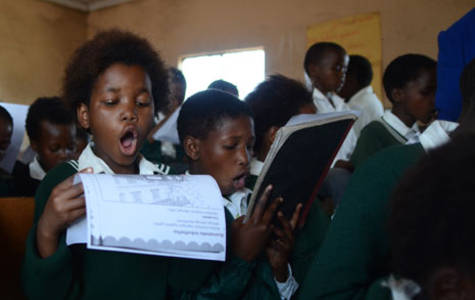UNESCO: No progress in reducing global number of children out of school
But some countries buck the trend and show rapid progress is possible
A new UNESCO policy paper shows that 58 million children aged 6 to 11 are still out of school, showing little overall improvement since 2007. But the paper highlights that positive change is possible, presenting the success of 17 countries that have reduced their out-of-school populations by almost 90 per cent in a little over a decade. These countries have invested in positive actions such as abolishing school fees, introducing more relevant curricula and providing financial support to struggling families.

Learners studying at Putuma JSS in overcrowded classrooms with a lack of desks and chairs.
This data will be presented by the Director-General of UNESCO, Irina Bokova, at a press conference in Brussels on 26 June during a pledging conference organized by the Global Partnership for Education, where donors and countries are expected to renew their commitment to get all children in school and learning.
“Combined with UNESCO’s recent news that aid to education has fallen yet again, the lack of progress in reducing out of school numbers confirms our fears – there is no chance whatsoever that countries will reach the goal of universal primary education by 2015,” said UNESCO Director-General Irina Bokova. “We cannot meet this news with further inertia. On the contrary, we must sound the alarm and mobilize the political will to ensure that every child’s right to education is respected.”
The new global out-of-school figures, produced by the UNESCO Institute for Statistics (UIS), show that around 43% of those out of school –15 million girls and 10 million boys – are unlikely ever to set foot in a classroom if current trends continue.
The lack of global progress is largely due to high population growth in sub-Saharan Africa, now home to more than 30 million out-of-school children. Most of these children will never start school and those who do are at risk of dropping out. Across the region, more than one in three children who entered the educational system in 2012 will leave before reaching the last grade of primary school.
The paper also shows critical gaps in the education of older children aged 12 to 15. Globally, 63 million adolescents were out of school in 2012. Although numbers have fallen by nearly one-third since 2000 in South and West Asia, the region has the largest population of out-of-school adolescents at 26 million. Sub-Saharan Africa is home to 21 million out-of-school adolescents and their numbers will continue to grow if current trends continue.
The paper includes analysis by the Education for All Global Monitoring Report showing that 17 countries, which accounted for about one-quarter of the global out-of-school population in 2000, bucked the trend by reducing their out-of-school populations by 86 per cent, from 27 million to less than 4 million, in little over a decade. In Nepal, for instance, 24% of children were out of school in 2000, but this rate fell to 1 per cent by 2013. Morocco’s out-of-school population fell by 96 per cent over the same period.
The analysis identifies six policies that have proven successful in helping primary school age children attend school and may offer useful lessons for other countries:
● Fee abolition: Burundi abolished school fees in 2005 and primary school enrolment in the country rose from 54 per cent to 94 per cent in six years.
● Social cash transfers: In Nicaragua, which introduced social cash transfers to help families offset the cost of schooling in 2000, the percentage of children who had never been to school fell from 17 per cent in 1998 to 7 per cent in 2009.
● Increased attention to ethnic and linguistic minorities: Morocco introduced the teaching of the local Amazigh language in primary schools in 2003 and saw the percentage of children who had never been to school fall from 9 per cent to 4 per cent from that date to 2009.
Increasing education expenditure: Ghana doubled education spending and saw the number of children enrolled in school rise from 2.4 million in 1999 to 4.1 million in 2013.
● Improving education quality: Viet Nam, which introduced a new curriculum that paid particular attention to disadvantaged learners, managed to more than halve the percentage of children who had never been to school between 2000 and 2010.
● Overcoming conflict: the gap in access to education between children in conflict areas and elsewhere in Nepal was closed by the time the civil war in the country ended in 2006, thanks to programmes that increased education opportunities, notably scholarships for marginalized groups.
“These countries face very different circumstances but all share the political will to bring about real change in education,” Irina Bokova noted. “While they have brought about momentous change, their task is far from complete – they must now ensure that every child completes school and learns the skills needed to lead a productive and healthy life. But today, others can learn from the experiences of these countries: they show that real progress is possible and we owe it to children to pursue it.”
Source: UN Educational Scientific and Cultural Organization
- 453 reads
Human Rights
Fostering a More Humane World: The 28th Eurasian Economic Summi

Conscience, Hope, and Action: Keys to Global Peace and Sustainability

Ringing FOWPAL’s Peace Bell for the World:Nobel Peace Prize Laureates’ Visions and Actions

Protecting the World’s Cultural Diversity for a Sustainable Future

Puppet Show I International Friendship Day 2020

